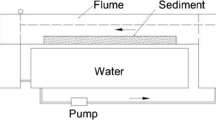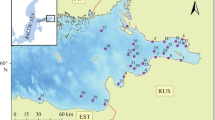Abstract
A comparative study was made of Cd accumulation in three species of Unionidae. Up to eleven weeks of exposure, patterns of accumulation in whole animal were biphasic and didn't differ essentially between the species. After the eleventh week, Cd uptake increased strongly inA. anatina, whereas inA. cygnea metal concentration remained at a constant level. This dissimilarity is discussed in terms of differing ventilation activity. Large differences were observed between corresponding organs of the species with regard to the Cd concentration (on the basis of organ dry weight). However, when comparing the normalized burden values (on the basis of total dry weight) differences were found to be small. In conclusion, in the comparison of related species, normalized burden rather than concentration has to be considered as the more realistic parameter of Cd accumulation. Comparing mussels of different condition (summer and winter animals) of the same species, accumulation patterns diverged when the parameter of Cd concentration was used, but not with the parameter of Cd burden; the total body or organ mass factor holds elements of differing, seasonally dependent weight (e.g., energy stores) that do not affect the extent of Cd uptake. Cd amounts and Cd concentrations (on a protein basis) were highest either in the nuclear fraction or in the cytosol in the two Anodonta species, depending on the organ. In gillsof A. anatina, and in midgut gland ofA. cygnea, 75% of total organ Cd was found in the nuclear fraction. A possible contribution of large membrane-limited vesicles and of calcium concretions to this fraction is discussed. Only in the kidney of either species was the amount of cytosolic Cd greater than that in the nuclear fraction. In the other cases, the ratio of Cd amounts in the nuclear and cytosolic fractions was about 3∶2. Partition of Cd between the total particulate and the non-particulate fraction was similar at 5 and 16 weeks of exposure. After gel filtration, total cytosolic Cd was recovered in a high-molecular weight (HMW) fraction and in a protein fraction with apparent MW of 11 kD. In gills, mantle, and midgut gland, the contribution of the latter fraction increased with exposure time.
Similar content being viewed by others
References
Abolins-Krogis A (1958) The morphological and chemical characteristics of organic crystals in regenerating shells ofHelix pomatia (L.). Acta Zool (Stockholm) 39:19–38
V.-Balogh K, Salánki J (1984) The dynamics of mercury and cadmium uptake into different organs ofAnodonta cygnea L. Water Res 18:1381–1387
Bergmeyer HU (1974) Phosphatase, acid. In Bergmeyer HU (ed) Methods of enzymatic analysis. Academic Press, London, pp 495–496
Bryan GW (1976) Heavy metal contamination in the sea. In Johnston R (ed) Marine Pollution. Academic Press, New York, pp 185–302
Coombs TL (1979) Cadmium in aquatic organisms. In: Webb M (ed) The chemistry, biochemistry and biology of cadmium. Elsevier, Amsterdam, pp 93–141
Ellis AE (1978) British freshwater bivalve mollusca. Academic Press, London
Frazier JM, George SG (1983) Cadmium kinetics in oysters—a comparative study ofCrassostrea gigas andOstrea edulis. Mar Biol 76:55–61
George SG, Pirie BJS (1979) The occurrence of cadmium in subcellular particles in the kidney of the marine mussel,Mytilus edulis, exposed to cadmium. The use of electron microprobe analysis. Biochim Biophys Acta 580:234–244
Greig RA (1979) Trace metal uptake by three species of molluscs. Bull Environ Contam Toxicol 22:643–647
Hemelraad J, Holwerda DA, Zandee DI (1986) Cadmium kinetics in freshwater clams. I. The pattern of cadmium accumulation inAnodonta cygnea. Arch Environ Contam Toxicol 15:1–7
Jansen AW, Vogel EF (1965) Freshwater molluscs in The Netherlands (in Dutch). Nieuw Leven N.V., the Hague
Janssen HH, Scholz N (1979) Uptake and cellular distribution of cadmium inMytilus edulis. Mar Biol 55:133–141
Julshamn K, Andersen K-J (1983a) Subcellular distribution of major and minor elements in unexposed molluscs in Western Norway-I. The distribution and binding of cadmium, zinc and copper in the liver and the digestive system of the oysterOstrea edulis. Comp Biochem Physiol 75A:9–12
— (1983b) Subcellular distribution of major and minor elements in unexposed molluscs in Western Norway-II. The distribution and binding of cadmium, zinc, copper, magnesium and iron in the kidney and the digestive system of the common musselMytilus edulis. Comp Biochem Physiol 75A:13–16
— (1983c) Subcellular distribution of the major and minor elements in unexposed molluscs in Western Norway-III. The distribution and binding of cadmium, zinc, copper, magnesium, manganese, iron and lead in the kidney and the digestive system of the horse musselModiolus modiolus. Comp Biochem Physiol 75A:17–20
Karnaukhov VN (1979) The role of filtrator molluscs rich in carotenoid in the self-cleaning of fresh waters. Symp Biol Hung 19:151–167
Karnaukhov VN, Milovidova NY, Kargopolova IN (1977) On a role of carotenoids in tolerance of sea molluscs to environment pollution. Comp Biochem Physiol 56A:189–193
Kmetec E (1966) Spectrophotometric method for the enzyme microdetermination of succinic acid. Anal Biochem 16:474–480
Marquenie JM (1984) Uptake and elimination in organisms. In: Heavy metals in aquatic ecosystems (in Dutch). Ministry for Transport and Public Works, the Hague, pp 33–56
Marshall AT, Talbot V (1979) Accumulation of cadmium and lead in gills ofMytilus edulis: X-ray microanalysis and chemical analysis. Chem-biol Interactions 27:111–123
Zs.-Nagy I (1977) Cytosomes (yellow pigment granules) of molluscs as cell organelles of anoxic energy production. Int Rev Cytol 49:331–377
NoËl-Lambot F (1976) Distribution of cadmium, zinc, and copper in the musselMytilus edulis: existence of cadmiumbinding proteins similar to metallothioneins. Experientia 32:324–326
Nolan CV, Duke EJ (1983) Cadmium-binding proteins inMytilus edulis: relation to mode of administration and significance in tissue retention of cadmium. Chemosphere 12:65–74
Olafson RW, Kearns A, Sim RG (1979) Heavy metal induction of metallothionein synthesis in the hepatopancreas of the crab,Scylla serrata. Comp Biochem Physiol 628:417–424
Pulido P, KÄgi JHR, Vallee BL (1966) Isolation and some properties of human metallothionein. Biochemistry 5:1768–1777
Ravera O (1984) Cadmium in freshwater ecosystems. Experientia 40:2–14
Ray S (1984) Bioaccumulation of cadmium in marine organisms. Experientia 40:14–23
Salánki J, V.-Balogh K, Berta E (1982) Heavy metals in animals of Lake Balaton. Water Res 16:1147–1152
Schacterle GR, Pollack RL (1973) A simplified method for quantitative assay of small amounts of protein in biological material. Anal Biochem 51:654–655
Sharma RP (1983) Ligands binding cadmium, zinc, and copper in a species of New Zealand oyster (Ostrea lutaria). Bull Environ Contam Toxicol 30:428–434
Silverman H, Steffens WL, Dietz TH (1983) Calcium concretions in the gills of a freshwater mussel serve as a calcium reservoir during periods of hypoxia. J Exp Zool 227:177–189
Simkiss K (1981) Cellular discrimination processes in metal accumulating cells. J Exp Biol 94:317–327
Steffens WL, Silverman H, Dietz TH (1985) Localization of antigens related to calcium-rich deposits in the gills of several freshwater bivalves. Can J Zool 63:348–354
Waalkes MP, Poirier LA (1984)In vitro cadmium-DNA interaction: cooperativity of cadmium binding and competitive antagonism by calcium, magnesium and zinc. Toxicoi Appl Pharmacol 75:539–546
Zadory L (1984) Freshwater molluscs as accumulation indicators for monitoring heavy metal pollution. Fresenius Z Anal Chem 317:375–379
Author information
Authors and Affiliations
Rights and permissions
About this article
Cite this article
Hemelraad, J., Holwerda, D.A., Teerds, K.J. et al. Cadmium kinetics in freshwater clams. II. A comparative study of cadmium uptake and cellular distribution in the UnionidaeAnodonta cygnea, Anodonta anatina, andUnio pictorum . Arch. Environ. Contam. Toxicol. 15, 9–21 (1986). https://doi.org/10.1007/BF01055244
Received:
Revised:
Issue Date:
DOI: https://doi.org/10.1007/BF01055244




